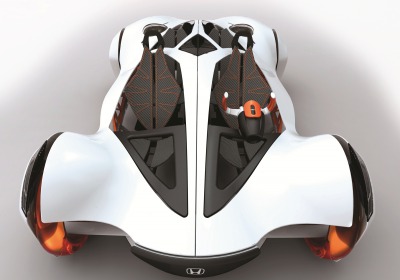2010 LA Design Challenge entrants revealed
Tue, 26 Oct 2010Entries for the 2010 Los Angeles Design Challenge have now been revealed. The futuristic proposals, which called for designers to envision a 1000lbs (454kg) 2+2 vehicle that delivers comfort, safety and satisfactory driving performance without sacrificing the emotional connection today's consumers demand from their vehicles, come from the west coast design studios of seven automakers – General Motors, Honda, Mazda, Mercedes-Benz, Nissan, Toyota and Volvo. For the first time since the Challenge's inception, studios outside California have also been allowed to enter the competition. These include proposals from Mercedes' Smart studio in Germany and the company's Maybach satellite studio in Japan.
Cadillac Aera
The Cadillac Aera (Aero+Era) is a proposal hailing from GM's Advanced Design studio. The ultra-light weight touring coupe embodies a minimalist approach in its design and features a highly advanced body structure inspired by nature that employs a 3D lattice, mono-formed frame. A pneumatic drive system (PDS) using compressed air ensures Cadillac's comfort is uncompromised, while pressurized air cells in the exterior skin enhance passive safety and interior comfort. Additional technologies include an all-in-one (AIO) wheel system, combining rotary actuator propulsion, steering and suspension functions and a vehicle to vehicle communication system that promotes active safety.
Honda Air
According to Honda, the Air concept is a coastal cruiser for the aggressive lifestyle. Inspired by the modern roller coaster as well as skydiving wing-suits, the Air weighs in at just under 800lbs. The concept features a hub-less wheel and drive system, glass reinforced seating panels, urethane tire composition and skeletal sub-frame components for drastic weight savings. Powered by a compressed air and pneumatic regulator system, the Air concept's chassis doubles as the master tank. All components, including seating, are mounted to the central chassis/tank to eliminate redundant structure and reduce overall weight. Vegetable based polymer panels and fairings protect occupants while maximizing the open air experience.
Maybach DRS
Mercedes-Benz's Japanese studio proposes the Maybach 'Den-Riki-Sha' (DRS), an electric powered rickshaw that is aligned with modern architecture, infrastructure and nature. Heralded as the first worldwide NMV (Naturally Manufactured Vehicle), the concept's production process is unique: Per a highly perfected and complex metamorphosis, a readily developed car is born out of a coded DNA-cocoon. Powered by a self balancing electric drive unit and controlled by an onboard computer that is plugged into a mega city's transport infrastructure, the Maybach DRS's human-electric hybrid allows pedaling power to be supplemented by the driver.
Mazda MX-0
Mazda's North American design team devised the MX-0 concept – a high-torque electric car developed around three key attributes: zero weight, zero carbon, zero mass. Starting with the MX-5 as a benchmark, the design team redesigned each of the cars components. By reducing, consolidating and replacing a multitude of MX-5 parts with fewer, simplified parts made from lightweight materials, the designers were able to significantly lower weight. Aimed at the global market of 2020, the MX-0 would have positive effects on the world's environment and economy by way of less energy consumption and minimized use of raw materials.
Mercedes-Benz Biome
The Mercedes-Benz Biome is an ultra-lightweight vehicle that is grown organically in the Mercedes-Benz Nursery through proprietary DNA. The customer's specific desires are genetically engineered into the star and the vehicle grows when this combines with the seed capsule. The interior of the Biome grows from Mercedes-Benz DNA in the front star, when it fuses with the seed. The exterior grows from the rear star, creating the shape. The wheels are grown separately from four unique seeds.
By employing a system called 'Symbiosis', the Biome collects energy from the sun and stores it in chemical bonds, in the form of a fluid called BioNectar4534. It is stored in a lightweight grown material called BioFibre, which is much lighter than metal or synthetic composites, but stronger than steel. Mercedes-Benz Symbiosis vehicles release pure oxygen into the environment, helping urban areas to meet air quality standards.
Continues →
By Eric Gallina

